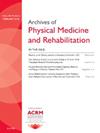AssistKey:轮椅辅助机器人的高效操作与模式选择
IF 3.6
2区 医学
Q1 REHABILITATION
Archives of physical medicine and rehabilitation
Pub Date : 2025-04-01
DOI:10.1016/j.apmr.2025.01.064
引用次数: 0
摘要
我们开发了AssistKey,它将模式控制和操作功能集成在一个紧凑的8键输入设备中,其中的键操作可以在6自由度辅助机械臂和抓取器的不同运动命令之间切换,并且可以在每个键的功能模式之间进行有效的切换。AssistKey旨在使辅助机器人在一个手指的有限活动范围内完成复杂的操作,提高用户在轮椅辅助机器人的帮助下进行日常生活活动的便利性和能力。DesignExperimental研究。在生物机器人实验室。实验对象:6名健康个体(年龄25-45岁;140 - 180磅重量;身高1.5-1.85米),用AssistKey操纵安装在轮椅上的辅助机器人执行ADL任务。干预:参与者坐在电动轮椅上。将多功能机器人辅助臂(mR2A)安装在轮椅上。参与者使用AssistKey来控制mR2A执行adl,例如在确定的工作空间中挑选/放置和操作对象。本研究的重点是评估用户使用AssistKey控制辅助机器人的易用性和能力,而不是使用轮椅操纵杆进行机器人操作。用户在不同运动方向之间切换的容易程度,以及用户输入所需运动的错误率作为性能指标。结果8键输入装置的直观设计,使用户能够高效地在不同模式之间切换,方便地控制多功能机器人辅助臂(mR2A)。然而,AssistKey上的按键距离太近可能会给准确按下单个按钮带来困难,而组合按钮的按下对于更复杂的操作来说,对于精细运动技能有限的个人来说尤其具有挑战性。结论:AssistKey的无缝功能提高了ADL的性能,但其设计需要针对不同运动技能的用户进行改进。未来的版本应该关注人体工程学的改进和自适应技术,以简化按钮的使用和管理复杂的操作。通过解决这些问题,AssistKey可以更好地服务于更广泛的残疾范围,提高用户的独立性和生活质量。本文章由计算机程序翻译,如有差异,请以英文原文为准。
AssistKey: Efficient Operation & Mode Selection of a Wheelchair-mounted Assistive Robot
Objectives
We have developed AssistKey, which incorporates mode control and operation functions in a compact 8-key input device in which the key operations can be switched between different motion commands of a 6 degrees of freedom assistive robotic arm and a gripper and an efficient method of switching between the function mode of each key. AssistKey aims to enable complex operations of an assistive robot within the limited activity range of a single finger, improving the user's ease and capability of performing activities of daily living (ADLs) with the help of a wheelchair-mounted assistive robot.
Design
Experimental study.
Setting
In the BioRobotics Laboratory.
Participants
We conducted experiments with 6 healthy individuals (age, 25-45y; weights, 140-180lb; height, 1.5-1.85m) to manipulate a wheelchair-mounted assistive robot with the AssistKey to perform ADL tasks.
Interventions
Participants are seated in a powered wheelchair. The multifunctional robotic assistive arm (mR2A) was mounted on the wheelchair. Participants used the AssistKey to control mR2A performing ADLs, such as picking/placing and manipulating objects in identified workspaces.
Main Outcome Measures
The study focused on assessing improvements in user's ease and capability of controlling the assistive robot using AssistKey in contrast of using the wheelchair joystick for robot operations. User's ease of switching between different directions of motion, and rate of error of user input for desired motion is used as the performance metric.
Results
Preliminary findings suggest that the intuitive design of the 8-key input device allowed users to efficiently switch between different modes and control the multifunctional robotic assistive arm (mR2A) with ease. However, the proximity of the keys on AssistKey may pose difficulties in accurately pressing individual buttons, and combined button presses, intended for more complex operations, were particularly challenging for individuals with limited fine motor skills.
Conclusions
The AssistKey's seamless functions enhance ADL performance, but its design needs refining for users with diverse motor skills. Future versions should focus on ergonomic improvements and adaptive technologies to ease button use and manage complex operations. By resolving these issues, AssistKey could better serve a broader disability spectrum, enhancing user independence and quality of life.
Disclosures
none.
求助全文
通过发布文献求助,成功后即可免费获取论文全文。
去求助
来源期刊
CiteScore
6.20
自引率
4.70%
发文量
495
审稿时长
38 days
期刊介绍:
The Archives of Physical Medicine and Rehabilitation publishes original, peer-reviewed research and clinical reports on important trends and developments in physical medicine and rehabilitation and related fields. This international journal brings researchers and clinicians authoritative information on the therapeutic utilization of physical, behavioral and pharmaceutical agents in providing comprehensive care for individuals with chronic illness and disabilities.
Archives began publication in 1920, publishes monthly, and is the official journal of the American Congress of Rehabilitation Medicine. Its papers are cited more often than any other rehabilitation journal.

 求助内容:
求助内容: 应助结果提醒方式:
应助结果提醒方式:


